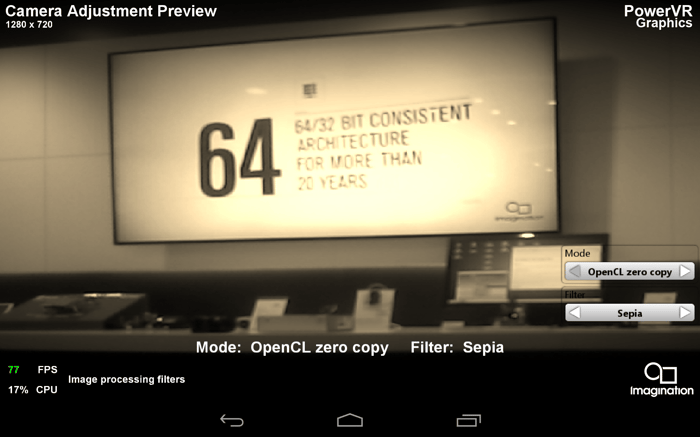- 23 July 2014
- Imagination Technologies
Intel® Atom™ processor Z3460/Z3480 supports OpenGL ES 3.0 and OpenCL 1.2 out of the box
Alexandru Voica contributes to ‘My week with’, a column covering consumer products that use IP technologies from Imagination.
When Intel first announced the new Atom Z3460/Z3480 (Merrifield) processors back in February, I was curious to find out the list of OEM partners which would launch the first devices to include these innovative chips.
Among the companies mentioned were Asus, Dell and Lenovo, all leading brands that have a tradition of producing affordable yet premium-looking hardware. I was therefore very happy to find out that since early July, consumers in the UK and US can get their hands on a brand new Dell Venue tablet.
Product design and hardware specifications
The refreshed Venue range of Android tablets from Dell is based on Intel Atom processors that run Android 4.4 KitKat. For those of you who aren’t familiar with the new Intel Atom Z3460/Z3480 processors, head over to AnandTech for a comprehensive review of their features and performance. Essentially, the Atom Z3460/Z3480 SoCs are 64-bit apps processors that include a dual-core CPU based on the Silvermont architecture and a quad-cluster PowerVR G6400 GPU capable of OpenGL® ES 3.1, OpenCL™ 1.2 and RenderScript.
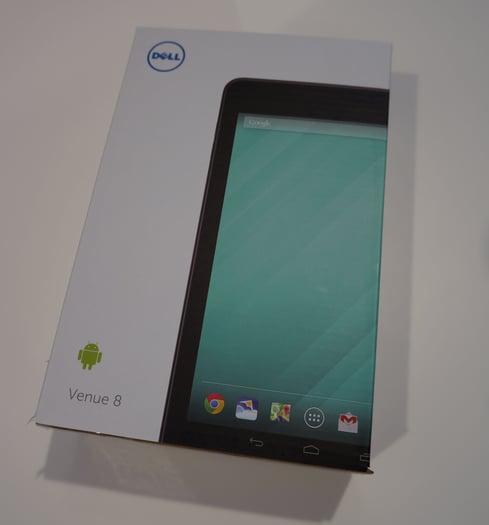 Dell Venue 8 comes in a simple, fuss-free package
Dell Venue 8 comes in a simple, fuss-free package
Both devices are lightweight, powerful and stylish tablets designed to entertain with high-resolution touchscreens and award-winning audio. Since the new Venue 8” tablet is less than 9 mm thin and weighs 370 gr (0.82 pounds for my American friends), I found it easy to hold and carry around the office. The back has a textured plastic cover so grip is greatly improved.
Additional specifications include a Full HD screen, high-speed 802.11ac and low-power Bluetooth 4.0 connectivity, 16 GB of internal storage, and a micro SD card slot for up to 64 GB of extra storage.
GPU performance
I am going to dedicate the larger part of this article to graphics performance since this device is among the first Android tablets to ship with a PowerVR Rogue GPU.
OpenGL ES 3.0 and graphics performance
PowerVR Rogue GPUs recently achieved OpenGL ES 3.1 conformance; this new API is set to be supported on devices running the upcoming Android L operating system. You can read more about the new OpenGL ES 3.1 API on our blog and see a quick demo of Rogue GPUs using compute shaders for image processing.
The PowerVR G6400 GPU inside the Dell Venue 8 tablet is a high performance, area-optimized graphics processor which includes four shading clusters and 128 ALU cores; at a peak frequency of 533 MHz, G6400 can deliver up to 136.44 GFLOPS. Since Android 4.4 supports OpenGL ES 3.0, I’ve loaded Soft Kitty and I was really impressed to see that the demo never drops below 35 fps! For a sequence that includes up to 200,000 triangles, this is really amazing performance from a device that costs only £179.
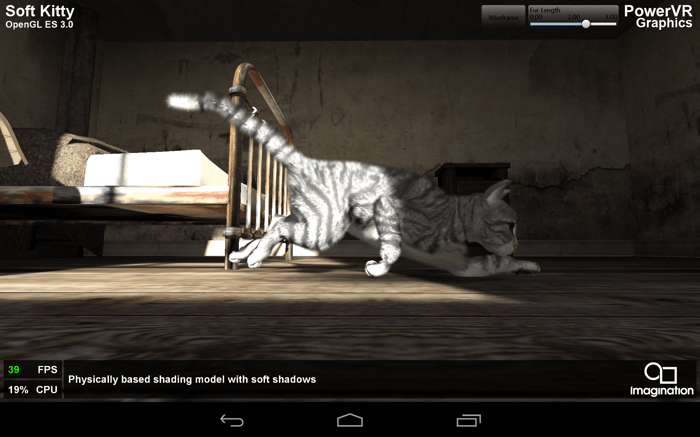 Our Soft Kitty OpenGL ES 3.0 demo running at Full HD resolution
Our Soft Kitty OpenGL ES 3.0 demo running at Full HD resolution
Thanks to our high performance, efficient GPU architecture, the tablet achieves impressive results across multiple graphics benchmarks, including GFXBench 3.0, Basemark X 1.1 and 3DMark. In the chart below, I’ve added four Android devices for a quick comparison of 1080p offscreen GPU performance using GFXBench from Kishonti.
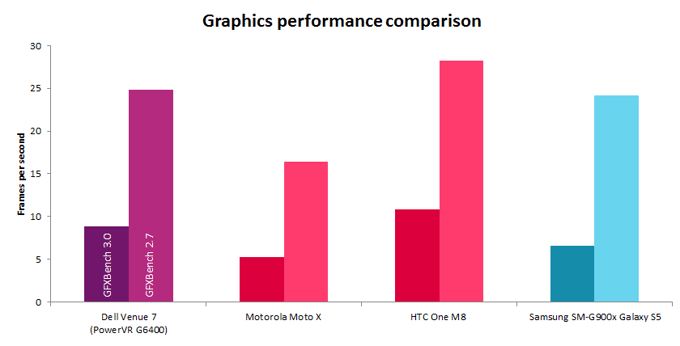 Both Dell Venue tablets stack up very well against mid-range and high-end devices
Both Dell Venue tablets stack up very well against mid-range and high-end devices
An important element to remember here is that two of the devices above retail for more than double the price of the Venue 8. The new Dell Venue tablets really deliver a lot of bang for their buck, offering consumers a high-performance, quad-cluster PowerVR GPU at a price point typical for an entry-level device.
Dell Venue 8 comes pre-bundled with OpenCL and RenderScript
From the chart above, you can see that PowerVR Rogue GPUs perform admirably when crunching through graphics tasks; however, these processors can be used for compute too. Running image and video processing at Full HD resolutions on a mobile device clearly requires a power efficient GPU since smartphones and tablets can become severely limited by the thermal envelope set by DVFS.
In the past OpenCL had only been available on developer boards but the Venue 8 tablet is the first consumer device to come with both OpenCL and RenderScript working out of the box. I’ve loaded our OpenCL Camera Adjustment image processing demo to offer you a quick comparison in performance.
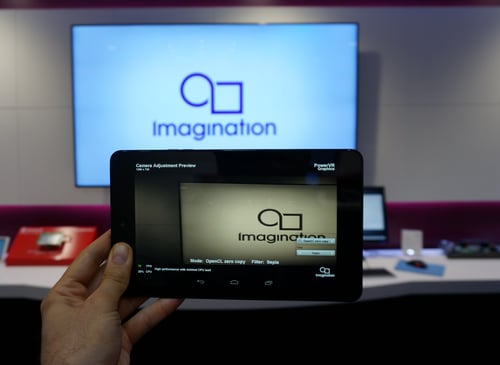 The new Dell Venue 8 tablet runs OpenCL out of the box
The new Dell Venue 8 tablet runs OpenCL out of the box
When running on our PowerVR G6400 GPU, the image processing demo averages around 74 fps while the Intel CPU peaks at 12 FPS. To put this into perspective, an Exynos-based Samsung Galaxy S4 using a PowerVR SGX544MP3 GPU was able to run the same demo at roughly 27 FPS.
Since the PowerVR GPU is clocked at a much lower frequency than the CPU, running these OpenCL kernels on the graphics processor not only improves performance dramatically but also saves considerable power – therefore preventing extreme overheating and rapid battery drain.
Furthermore, all Rogue GPUs have been designed for efficient GPU compute, featuring separate data paths that have been optimized for low-power compute and improved support for local memory .
The Camera Adjustment OpenCL app has multiple filters you can play with, including sepia, fisheye, saturation, watercolor, edge detect, Gaussian blur or chroma key
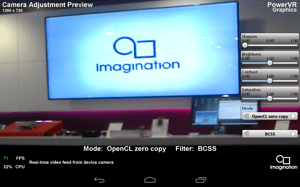 |
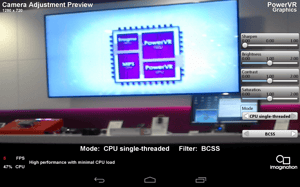 |
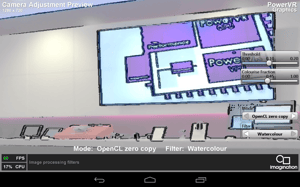 |
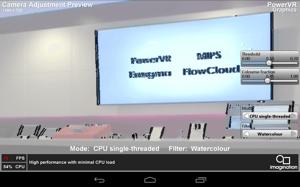 |
Running the compute kernels on the PowerVR G6400 GPU vs. the main CPU results in a 6x performance boost
If you are developer interested in experimenting with OpenCL on PowerVR, we will soon be releasing our Early Access Programme for PowerVR Rogue; until then, you can download our PowerVR Rogue OpenCL programmer’s reference manual and our OpenCL real-time Camera Adjustment app – both are subject to a click-through NDA.
For our readers in the US, Dell is currently selling the Venue 7 tablet for only $159.99, whereas the Dell Venue 8 can be acquired for $179.99. If you live in Great Britain, you can buy a new Dell Venue 8 tablet from the company’s UK website – prices start at £179.
We want to hear from you
One of the great things about working for Imagination is observing first-hand the breadth of our technologies working in end products. The amazing hard work that our engineering, sales and marketing and support teams put in enables our partners to continue designing better products, from the iconic smartphones, tablets or smart TVs that we use every day to the enterprise backbone servers that handle trillions of operations per second.
These articles aim to give consumers an overview of the large and diverse markets we operate in. I will be covering a range of interesting products from each segment market while focusing on how our technologies deliver new user experiences.



